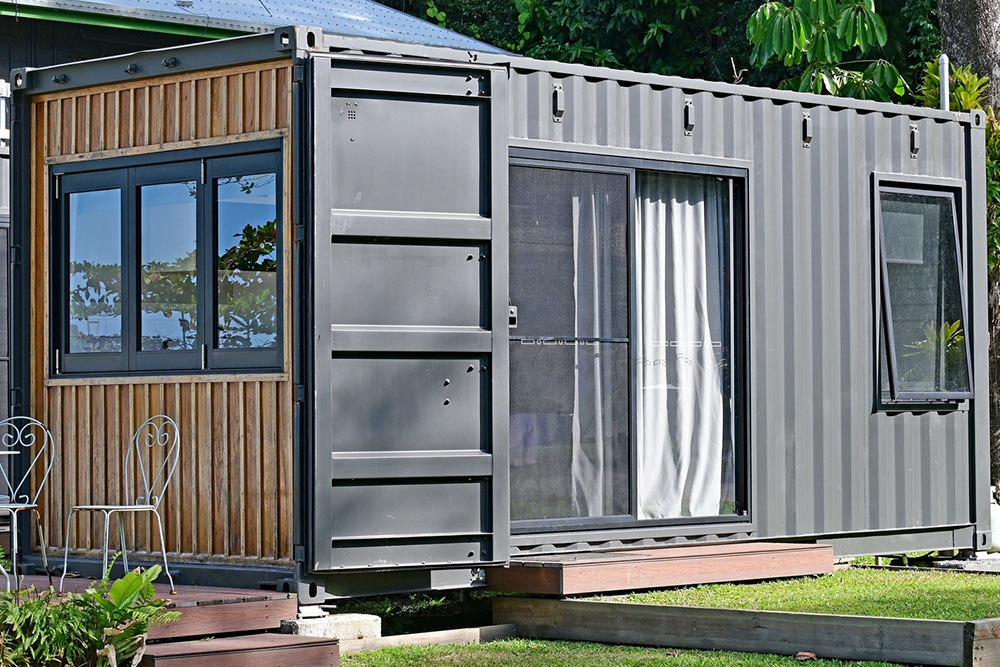Container house – Designs, permits, and tips for buying one
Over the last few years, container houses have become quite popular, particularly for restaurants and other commercial establishments. This trend has also influenced personal living choices, with many homebuyers choosing container homes thanks to their affordability, eco-friendliness, customisation, mobility, and quick construction. As a result, there has been rapid progress and development in the style and amenities available in these homes, drawing more interest from people around the continent.
Introduction to container homes
Container homes or shipping container homes are new or used shipping containers that have been repurposed and modified to create a home with all the regular features, such as windows, doors, and insulation.

The construction of container homes is also incredibly quick since the basic structure is already built. They also have minimal requirements for a foundation: a level and compact ground or a concrete footing. This helps individuals save more money.
That said, one common concern concerning container housing revolves around its strength and durability. However, there is nothing to worry about here. Shipping containers are built to carry heavy loads, stack up easily, and withstand harsh weather conditions with winds up to 280 kilometers per hour. This makes them quite robust and structurally sound.
The shallow depth of the walls of container homes also presents a unique issue:
Designing a container home
This modern housing style offers a lot more sustainability, as they make good use of old containers that are no longer needed. The modification and “construction” also occur in a controlled environment, further adding to their environment-friendly appeal. They can easily be cut and welded to create any configuration or layout to suit individual needs without too much fuss. As a result, design possibilities are virtually limitless with container homes. Container homes can accommodate a range of requirements, from compact studios to large, spacious family residences.
For instance, one can opt for a container home with a minimalist design and a modern finish or give in to their whimsies to maximise the space available. Open-plan layouts, large windows, and versatile furniture can further help add to the home’s modern appeal. Alternatively, one can also give into the industrial appeal of the container itself and enhance it with wood and stone interiors to create a warm yet charming home.
Local permits required for container homes
Modular construction, such as container homes, is a relatively new phenomenon in the architectural world, so laws and regulations vary widely from area to area. That said, the federal building code in the country regulates permissions for all kinds of homes, be it a container or a building.
Common factors that affect the application of a container home include their intended installation time, size, development, and land use plan; visual appearance; distances to property boundaries; nature; and water conservation restrictions; safety standards, such as fire protection; and technical equipment planning, including energy and water supply.
One needs to get authorisations for technical and construction-related details, such as insulation and energy efficiency, external connections (gas, heating, etc.), hot water systems, wastewater disposal and sewage, load capacity, and foundations, to get the appropriate planning permissions for a container home.
Tips for finding container homes for sale
The price of container homes depends on their size, design, materials, and other customisations. They can cost anywhere from €20,000 for simple, compact units to over €100,000 for fully furnished and customised homes. Keeping certain tips in mind can help one find the right container home for their needs.
- Work with a reputable builder
Container homes come in all shapes and sizes, and to find the one that is perfect for one’s needs, it is important to work with someone who understands the vision and can deliver it within a set time frame. That is why one must start their search here.One can check with family, friends, and neighbors to find leads for a reputable builder. It may also be interesting to find people who live in container homes and talk to them about their experiences working with certain companies. Alternatively, a simple browser search can search the internet and find a list of container home builders in their area.
-
Understand legal requirements
Next, it is essential to understand the local and federal requirements and zoning laws to get the right permissions for one’s home. This will ensure that the home abides by recommended safety guidelines and that any state authorities will not remove it after construction or installation. -
Find a comprehensive package
It is best to look for a container builder who offers a comprehensive package, including container home kits, architectural design, and installation services to avoid running around and juggling multiple vendors. This can help one ensure a seamless construction and move-in process. One should ensure that they compare rates between competitors to find a reasonable price.

